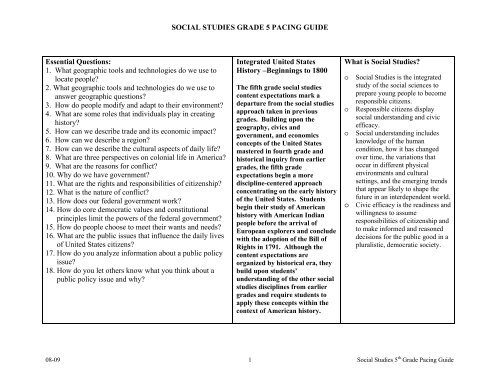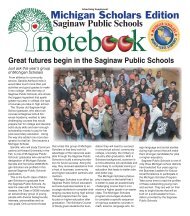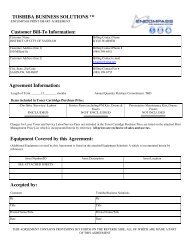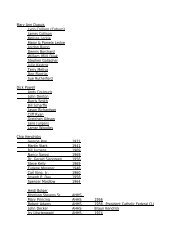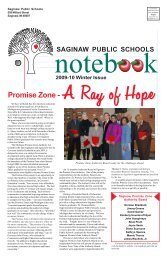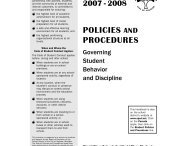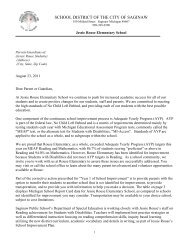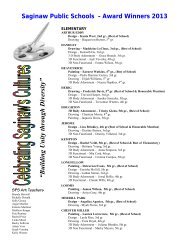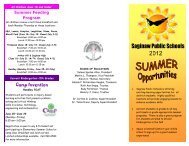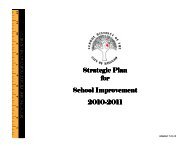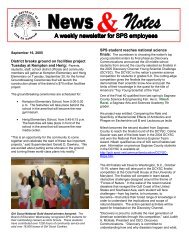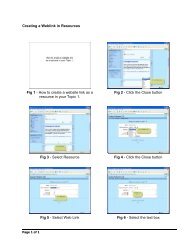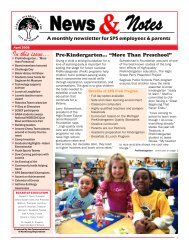SOCIAL STUDIES GRADE 5 PACING GUIDE Essential Questions: 1 ...
SOCIAL STUDIES GRADE 5 PACING GUIDE Essential Questions: 1 ...
SOCIAL STUDIES GRADE 5 PACING GUIDE Essential Questions: 1 ...
Create successful ePaper yourself
Turn your PDF publications into a flip-book with our unique Google optimized e-Paper software.
<strong>SOCIAL</strong> <strong>STUDIES</strong> <strong>GRADE</strong> 5 <strong>PACING</strong> <strong>GUIDE</strong><br />
<strong>Essential</strong> <strong>Questions</strong>:<br />
1. What geographic tools and technologies do we use to<br />
locate people?<br />
2. What geographic tools and technologies do we use to<br />
answer geographic questions?<br />
3. How do people modify and adapt to their environment?<br />
4. What are some roles that individuals play in creating<br />
history?<br />
5. How can we describe trade and its economic impact?<br />
6. How can we describe a region?<br />
7. How can we describe the cultural aspects of daily life?<br />
8. What are three perspectives on colonial life in America?<br />
9. What are the reasons for conflict?<br />
10. Why do we have government?<br />
11. What are the rights and responsibilities of citizenship?<br />
12. What is the nature of conflict?<br />
13. How does our federal government work?<br />
14. How do core democratic values and constitutional<br />
principles limit the powers of the federal government?<br />
15. How do people choose to meet their wants and needs?<br />
16. What are the public issues that influence the daily lives<br />
of United States citizens?<br />
17. How do you analyze information about a public policy<br />
issue?<br />
18. How do you let others know what you think about a<br />
public policy issue and why?<br />
Integrated United States<br />
History –Beginnings to 1800<br />
The fifth grade social studies<br />
content expectations mark a<br />
departure from the social studies<br />
approach taken in previous<br />
grades. Building upon the<br />
geography, civics and<br />
government, and economics<br />
concepts of the United States<br />
mastered in fourth grade and<br />
historical inquiry from earlier<br />
grades, the fifth grade<br />
expectations begin a more<br />
discipline-centered approach<br />
concentrating on the early history<br />
of the United States. Students<br />
begin their study of American<br />
history with American Indian<br />
people before the arrival of<br />
European explorers and conclude<br />
with the adoption of the Bill of<br />
Rights in 1791. Although the<br />
content expectations are<br />
organized by historical era, they<br />
build upon students’<br />
understanding of the other social<br />
studies disciplines from earlier<br />
grades and require students to<br />
apply these concepts within the<br />
context of American history.<br />
What is Social Studies?<br />
o Social Studies is the integrated<br />
study of the social sciences to<br />
prepare young people to become<br />
responsible citizens.<br />
o Responsible citizens display<br />
social understanding and civic<br />
efficacy.<br />
o Social understanding includes<br />
knowledge of the human<br />
condition, how it has changed<br />
over time, the variations that<br />
occur in different physical<br />
environments and cultural<br />
settings, and the emerging trends<br />
that appear likely to shape the<br />
future in an interdependent world.<br />
o Civic efficacy is the readiness and<br />
willingness to assume<br />
responsibilities of citizenship and<br />
to make informed and reasoned<br />
decisions for the public good in a<br />
pluralistic, democratic society.<br />
08-09 1<br />
Social Studies 5 th Grade Pacing Guide
<strong>SOCIAL</strong> <strong>STUDIES</strong> <strong>GRADE</strong> 5 <strong>PACING</strong> <strong>GUIDE</strong><br />
Era 1: Beginnings to 1620: Beginning with pre-Columbian times, the expectations focus on American Indians living in North<br />
American before European exploration.<br />
o The geographic concepts of spatial awareness, places and regions, human systems, and human-environment interactions are addressed<br />
throughout the era as students study American history to 1620.<br />
o The expectations deliberately expand upon students’ knowledge of American Indians living in Michigan and the concept of regions from<br />
previous grades.<br />
o In examining European exploration and conquest, the expectations embed geographic, civics, and economic concepts, and revisit the case<br />
study method used by historians to explain the technological and political developments that made exploration possible.<br />
o In deepening understanding of perspective, students also explore the goals, obstacles, motivations, and consequences of European exploration<br />
and the subsequent colonization of the Americas.<br />
o The expectations also include an introduction to life in Africa as a foundation for examining interactions among Europeans, American Indians,<br />
Africans from the 15 th through the 17 th centuries with a focus on how economic concepts influenced the behavior of people and nations.<br />
o Students apply the tools of the historian by using primary and secondary sources to compare European and American Indian cultures, using<br />
previously established criteria.<br />
o The expectations also focus on the interaction among Europeans, American Indians, and Africans, by exploring the impact of European<br />
contact on American Indian cultures, comparing the approaches of the British and French in their interactions with American Indians, and<br />
examining the Columbian Exchange and its impact on all three groups.<br />
Era 2: Colonization and Settlement: In learning about regional settlement patterns and significant developments of the three<br />
distinct colonial regions prior to the American Revolution, students apply their conceptual understanding of regions and the<br />
geography of the United States.<br />
o They explore how the geography influenced people’s daily lives and economic activities as three distinct colonial regions developed.<br />
o The expectations require students to apply concepts of government and economics to further understand the Southern, New England, and<br />
Middle colonies as they learn about the establishment of colonial settlements, development of colonial governments, role of religion,<br />
relationships between colonists and American Indians, and development of the institution of slavery.<br />
o Using geography, students explore how human systems such as religion, movement of people, and ethnic diversity led to the establishment of<br />
other colonies within particular regions.<br />
o Special attention is paid to the European slave trade and slavery in Colonial America as students explore the lives of enslaved peoples and free<br />
Africans living in the American colonies.<br />
o Fifth grade students enhance their understanding of historical perspectives by analyzing the perspectives of different groups living in colonial<br />
08-09 2<br />
Social Studies 5 th Grade Pacing Guide
<strong>SOCIAL</strong> <strong>STUDIES</strong> <strong>GRADE</strong> 5 <strong>PACING</strong> <strong>GUIDE</strong><br />
America.<br />
o By comparing the different colonial regions that developed with respect to politics, economics, religion, social institutions, and humanenvironment<br />
interactions, the expectations prepare students for American history in middle school serving as a precursors for the regional and<br />
racial issues that culminated in the Civil War.<br />
Era 3: Revolution and the New Nation: In studying the American Revolution and the New Nation, the expectations<br />
deliberately build upon students’ prior knowledge in government and economics.<br />
o The political and economic aspects of the French and Indian War and its aftermath are stressed.<br />
o Students deepen their understanding of perspective by comparing patriot and loyalist perspectives with respect to events that eventually<br />
culminated in the American Revolution.<br />
o The expectations in this historical era emphasize significant ideas about government as reflected in the Declaration of Independence and the<br />
role of key individuals and groups in declaring independence.<br />
o Students also apply concepts of power and authority to the perspectives of the colonists and the British during the revolutionary era.<br />
o Emphasis is placed on how colonial experiences and ideas about government influenced the decision of the colonists to declare independence.<br />
o Students examine the course, character, and consequences of the American Revolution, using geography and economics to compare the<br />
advantages and disadvantages of each side in the war.<br />
o Students also describe the significant events and turning points during the war.<br />
o In examining the challenges faced by the new nation under the Articles of Confederation, the expectations continue to build upon students’<br />
understanding of government.<br />
o By exploring the political ideas underlying the Articles of Confederation and the subsequent adoption of the U.S. Constitution and Bill of<br />
Rights (with particular emphasis on the rights contained in the first four amendments), the values and principles of American democracy are<br />
revisited through a historical context.<br />
o Students examine how the Founders sought to limit the power of government through principles of separation of powers, checks and balances,<br />
dual sovereignty (federalism) protection of individual rights, popular sovereignty, and rule of law.<br />
08-09 3<br />
Social Studies 5 th Grade Pacing Guide
<strong>SOCIAL</strong> <strong>STUDIES</strong> <strong>GRADE</strong> 5 <strong>PACING</strong> <strong>GUIDE</strong><br />
H1 The World in Temporal Terms: Historical Habits of Mind (Ways of Thinking)<br />
Evaluate evidence, compare and contrast information, interpret the historical record, and develop sound historical arguments and perspectives on<br />
which informed decisions in contemporary life can be based.<br />
H1.1 Temporal Thinking<br />
Use historical conceptual devices to organize and study the past.<br />
Historians use conceptual devices (eras, periods, calendars, time lines) to organize their study of the world. Chronology is based on<br />
time and reflects cultural and historical interpretations, including major starting points, and calendars based on different criteria<br />
(religious, seasonal, Earth-sun-and-moon relationships). Historians use eras and periods to organize the study of broad developments<br />
that have involved large segments of world’s population and have lasting significance for future generations and to explain change and<br />
continuity.<br />
H1.2 Historical Inquiry and Analysis<br />
Use historical inquiry and analysis to study the past.<br />
History is a process of reasoning based on evidence from the past. Historians use and interpret a variety of historical documents<br />
(including narratives), recognize the difference between fact and opinion, appreciate multiple historical perspectives while avoiding<br />
present mindedness(judging the past solely in terms of norms and values of today), and explain that historical events often are the<br />
result of multiple causation. Students will conduct their own inquiry and analysis in their studies about United States History, an<br />
Investigation Topic and Issue Analysis, Past and Present.<br />
H1.4 Historical Understanding<br />
Use historical concepts, patterns, and themes to study the past.<br />
Historians apply temporal perspective, historical inquiry, and analysis to spheres of human society to construct knowledge as<br />
historical understandings. These understandings are drawn from the record of human history and include human aspirations,<br />
strivings, accomplishments, and failures in spheres of human activity.<br />
08-09 4<br />
Social Studies 5 th Grade Pacing Guide
<strong>SOCIAL</strong> <strong>STUDIES</strong> <strong>GRADE</strong> 5 <strong>PACING</strong> <strong>GUIDE</strong><br />
G1 The World in Spatial Terms: Geographical Habits of Mind<br />
Describe the relationships between people, places, and environments by using information that is in a geographic (spatial) context. Engage in mapping<br />
and analyzing the information to explain the patterns and relationships they reveal both between and among people, their cultures, and the natural<br />
environment. Identify and access information, evaluate it using criteria based on concepts and themes, and use geography in problem solving and<br />
decision-making. Explain and use key conceptual devices (places and regions, spatial patterns and processes) that geographers use to organize<br />
information and inform their study of the world.<br />
G1.1 Spatial Thinking<br />
Use maps and other geographic tools to acquire and process information from a spatial perspective.<br />
Geographers use published maps, sketch (mental) maps, and other geographic representations, tools, and technologies to acquire, organize,<br />
process, and report information from a spatial perspective. World maps made for specific purposes (population distribution, climate patterns,<br />
vegetation patterns) are used to explain the importance of maps in presenting information that can be compared, contrasted, and examined to<br />
answer the questions “Where is something located?” and “Why is it located there?” Students will begin with global scale and then refocus the<br />
scale to study the region of the Western Hemisphere, and, finally, focus on a specific place.<br />
G1.2 Geographical Inquiry and Analysis<br />
Use geographic inquiry and analysis to answer important questions about relationships between people, cultures, their environment, and relations<br />
within the larger world context.<br />
Geographers use information and skills to reach conclusions about significant questions regarding the relationships between people, their cultures,<br />
the environments in which they live, and the relationships within the larger world context. Students will reach their own conclusions using this<br />
information and make a reasoned judgment about the most justifiable conclusion based on the authenticity of the information, their skill at<br />
critically analyzing the information, and presenting the results of the inquiry.<br />
G1.3 Geographical Understanding<br />
Use geographic themes, knowledge about processes and concepts to study the Earth.<br />
The nature and uses of geography as a discipline and the spatial perspective require that students observe, interpret, assess, and apply geographic<br />
information and skills. The uses of the subject and content of geography are essential in the development of geographical understanding. A spatial<br />
perspective enables student to observe, describe, and analyze the organizations of people, places, and environments at different scales and is<br />
central to geographic literacy.<br />
08-09 5<br />
Social Studies 5 th Grade Pacing Guide
<strong>SOCIAL</strong> <strong>STUDIES</strong> <strong>GRADE</strong> 5 <strong>PACING</strong> <strong>GUIDE</strong><br />
Core Democratic Values (Ideals of democracy; rights and<br />
responsibilities; self-governance; respect for individual worth; and respect for<br />
human dignity)<br />
CDV in bold = current grade level; ( ) = previous grade level taught<br />
o Life<br />
o Justice (1 st )<br />
o Truth<br />
o Fairness (K, 1 st )<br />
o Diversity<br />
o Pursuit of Happiness<br />
o Liberty<br />
o Equality<br />
o Patriotism (2 nd )<br />
o Common Good (K, 2 nd , 3 rd )<br />
o Popular Sovereignty (4 th )<br />
Constitutional Principles<br />
o The Rule of Law (K, 1 st , 3 rd )<br />
o Separation of Powers (3 rd , 4 th )<br />
o Representative Government (3 rd )<br />
o Checks and Balances (4 th )<br />
o Individual Rights (2 nd , 3 rd , 4 th )<br />
o Freedom of Religion (3 rd , 4 th )<br />
o Federalism<br />
o Civilian Control of the Military<br />
The Responsible Citizen<br />
o Uses knowledge of the past to construct meaningful understanding of our diverse cultural heritage and inform his/her civic judgments<br />
(Historical Perspective)<br />
o Uses knowledge of spatial patterns on earth to understand processes that shape both the natural environments and the diverse societies that<br />
inhabit them (Geographic Perspective)<br />
o Uses knowledge of American government and politics to make decisions about governing his/her community. (Civic Perspective)<br />
o Uses knowledge of the production, distribution and consumption of goods and services to maker personal, career and societal decisions about<br />
the use of scarce resources (Economic Perspective)<br />
o Uses methods of social science investigation to answer questions about society (Inquiry)<br />
o Constructs and expresses reasoned positions on public issues (Public Discourse and Decision Making)<br />
o Acts constructively to further the common good (Citizen Involvement)<br />
08-09 6<br />
Social Studies 5 th Grade Pacing Guide
<strong>SOCIAL</strong> <strong>STUDIES</strong> <strong>GRADE</strong> 5 <strong>PACING</strong> <strong>GUIDE</strong><br />
Power Standards<br />
o K1.1 Know the defining characteristics of the social studies discipline.<br />
o K1.2 Know that each discipline is subject to criticisms and limitations; be aware of the primary criticisms and limitations of social studies.<br />
o K1.3 Understand and analyze social relationships and patterns.<br />
o K1.8 Apply social studies concepts to better understand major current local, national, and world events, issues, and problems.<br />
o K1.10 Understand significant concepts, generalizations, principles, and theories of the social studies disciplines.<br />
o P1.1 Use close and critical reading strategies to read and analyze complex texts pertaining to social science; attend to nuance, make<br />
connections to prior knowledge, draw inferences, and determine main idea and supporting details.<br />
o P1.2 Analyze point of view, context, and bias to interpret primary and secondary source documents.<br />
o P2.2 Read and interpret data in tables and graphs.<br />
o P2.3 Know how to find and organize information from a variety of sources; analyze, interpret, support interpretations with evidence;<br />
Critically evaluate, and present the information orally and in writing; report investigation results effectively.<br />
o P2.5 Use deductive and inductive problem-solving skills as appropriate to the problem being studied.<br />
o P3.2 Deeply examine policy issues in group discussions and debates (clarify issues, consider opposing views, apply democratic values or<br />
Constitutional principles, anticipate consequences) to make reasoned and informed decisions.<br />
o P4.1 Act out of respect for the rule of law and hold others accountable to the same standards.<br />
o P4.3 Plan and conduct activities intended to advance views on matters of public policy, report the results, and evaluate effectiveness.<br />
08-09 7<br />
Social Studies 5 th Grade Pacing Guide
<strong>SOCIAL</strong> <strong>STUDIES</strong> <strong>GRADE</strong> 5 <strong>PACING</strong> <strong>GUIDE</strong><br />
MDE Policy on Learning Expectations<br />
o Gather Information<br />
o Understand Information<br />
o Analyze Issues<br />
o Draw and Justify Conclusions<br />
o Organize and Communicate Information<br />
o Think and Communicate Critically<br />
o Learn and Consider Issues Collaboratively<br />
o Learn Independently<br />
o Create Knowledge<br />
o Act Ethically<br />
21 st Century Literacy Skills (21 st Century Workforce Commission, National Alliance of Business)<br />
o Basic, scientific, technological, financial, economic, and civic literacy<br />
o Visual and information literacy<br />
o Cultural literacy and global awareness<br />
o Adaptability, ability to manage complexity, and self-direction<br />
o Curiosity, creativity, and risk-taking<br />
o Higher order thinking and sound reasoning<br />
o Teaming and collaboration<br />
o Personal and social responsibility<br />
o Interactive communication<br />
o Prioritizing, planning, and managing for results<br />
o Effective use of real-world tools<br />
o High quality results with real-world application<br />
08-09 8<br />
Social Studies 5 th Grade Pacing Guide
<strong>SOCIAL</strong> <strong>STUDIES</strong> <strong>GRADE</strong> 5 <strong>PACING</strong> <strong>GUIDE</strong><br />
1st<br />
U1.1 American Indian Life in the<br />
Americas<br />
Describe the life of peoples living in North<br />
America before European exploration.<br />
o Use maps to locate peoples in the<br />
desert Southwest, the Pacific<br />
Northwest, the nomadic nations of the<br />
Great Plains, and the woodland<br />
peoples east of the Mississippi River<br />
(Eastern Woodland) 5 – U1.1.1<br />
o Compare how American Indians in the<br />
desert Southwest and the Pacific<br />
Northwest adapted to or modified the<br />
environment<br />
5 – U1.1.2<br />
o Describe Eastern Woodland American<br />
Indian life with respect to<br />
governmental and family structures,<br />
trade, and views on property<br />
ownership and land use 5 – U1.1.3<br />
U1.2 European Exploration<br />
Identify the causes and consequences of<br />
European exploration and colonization.<br />
o Explain the technological (e.g.,<br />
invention of the astrolabe and improved<br />
maps), and political developments,<br />
(e.g., rise of nation-states), that made sea<br />
exploration possible<br />
5 – U1.2.1<br />
o Use case studies of individual<br />
explorers and stories of life in Europe<br />
to compare the goals, obstacles,<br />
motivations, and consequences for<br />
European exploration and<br />
colonization of the Americas (e.g.,<br />
economic, political, cultural, and religious)<br />
5 – U1.2.2<br />
U1.3 African Life Before the 16th<br />
Century<br />
Describe the lives of peoples living in<br />
western Africa prior to the 16th century.<br />
o Use maps to locate the major<br />
regions of Africa (northern Africa,<br />
western Africa, central Africa, eastern<br />
Africa, southern Africa)<br />
5 – U1.3.1<br />
o Describe the life and cultural<br />
development of people living in<br />
western Africa before the 16 th<br />
century with respect to economic<br />
(the ways people made a living) and<br />
family structures, and the growth<br />
of states, towns, and trade 5 – U1.3.2<br />
08-09 9<br />
Social Studies 5 th Grade Pacing Guide
<strong>SOCIAL</strong> <strong>STUDIES</strong> <strong>GRADE</strong> 5 <strong>PACING</strong> <strong>GUIDE</strong><br />
1st<br />
U1.4 Three World Interactions<br />
Vocabulary/Concepts/Skills<br />
Vocabulary/Concepts/Skills<br />
Describe the environmental, political, and cultural<br />
consequences of the interactions among European,<br />
African, and American Indian peoples in the late 15th<br />
through the 17th century.<br />
o Describe the convergence of Europeans,<br />
American Indians and Africans in North<br />
America after1492 from the perspective of<br />
these three groups 5 – U1.4.1<br />
o Use primary and secondary sources (e.g., letters,<br />
diaries, maps, documents, narratives, pictures, graphic<br />
data) to compare Europeans and American<br />
Indians who converged in the western<br />
hemisphere after 1492 with respect to<br />
governmental structure, and views on property<br />
ownership and land use 5 – U1.4.2<br />
o Explain the impact of European contact on<br />
American Indian cultures by comparing the<br />
different approaches used by the British and<br />
French in their interactions with American<br />
Indians 5 – U1.4.3<br />
o Describe the Columbian Exchange and its<br />
impact on Europeans, American Indians, and<br />
Africans 5 – U1.4.4<br />
Maps<br />
Regions<br />
Directions<br />
Relationship between location and<br />
climate<br />
Structure and purpose of government<br />
Structure of families<br />
Economic concept of trade<br />
Rights of individuals<br />
Technological development<br />
Political development<br />
Sea exploration<br />
Case study<br />
European exploration<br />
European colonization<br />
The Americas<br />
Cultural development<br />
Telling time by centuries<br />
Economic structure<br />
Growth of nation states<br />
Growth of towns<br />
Growth of trade<br />
European<br />
American Indian<br />
Western African<br />
Perspective<br />
Primary source<br />
Secondary source<br />
Western hemisphere<br />
Chronology by centuries<br />
Views of property ownership<br />
Views on land use<br />
American Indian culture<br />
British<br />
French<br />
Columbian Exchange<br />
Europeans<br />
08-09 10<br />
Social Studies 5 th Grade Pacing Guide
<strong>SOCIAL</strong> <strong>STUDIES</strong> <strong>GRADE</strong> 5 <strong>PACING</strong> <strong>GUIDE</strong><br />
2 nd U2.1 European Struggle for Control of North America<br />
Compare the regional settlement patterns and describe significant developments in Southern, New England, and the mid-Atlantic colonies.<br />
o Describe significant developments in the Southern colonies, including 5 – U2.1.1<br />
• patterns of settlement and control including the impact of geography (landforms and climate) on settlement<br />
• establishment of Jamestown<br />
• development of one-crop economies (plantation land use and growing season for rice in Carolinas and tobacco in Virginia)<br />
• relationships with American Indians (e.g., Powhatan)<br />
• development of colonial representative assemblies (House of Burgesses)<br />
• development of slavery<br />
o Describe significant developments in the New England colonies, including 5 – U2.1.2<br />
• patterns of settlement and control including the impact of geography (landforms and climate) on settlement<br />
• relations with American Indians (e.g., Pequot/King Phillip’s War)<br />
• growth of agricultural (small farms) and non-agricultural (shipping, manufacturing) economies<br />
• the development of government including establishment of town meetings, development of colonial legislatures and<br />
growth of royal government<br />
• religious tensions in Massachusetts that led to the establishment of other colonies in New England<br />
o Describe significant developments in the Middle Colonies, including 5 – U2.1.3<br />
• patterns of settlement and control including the impact of geography (landforms and climate) on settlement<br />
• the growth of Middle Colonies economies (e.g., breadbasket)<br />
• the Dutch settlements in New Netherlands, Quaker settlement in Pennsylvania, and subsequent English takeover of the<br />
Middle Colonies<br />
• immigration patterns leading to ethnic diversity in the Middle Colonies<br />
o Compare the regional settlement patterns of the Southern colonies, New England, and the Middle Colonies 5 – U2.1.4<br />
08-09 11<br />
Social Studies 5 th Grade Pacing Guide
<strong>SOCIAL</strong> <strong>STUDIES</strong> <strong>GRADE</strong> 5 <strong>PACING</strong> <strong>GUIDE</strong><br />
2 nd U2.2 European Slave Trade and<br />
Slavery in Colonial America<br />
Analyze the development of the slave<br />
system in the Americas and its impact<br />
upon the life of Africans.<br />
o Describe Triangular Trade<br />
including 5 – U2.2.1<br />
• the trade routes<br />
• the people and goods that were<br />
traded<br />
• the Middle Passage<br />
• its impact on life in Africa<br />
o Describe the life of enslaved<br />
Africans and free Africans in the<br />
American colonies 5 – U2.2.2<br />
o Describe how Africans living in<br />
North America drew upon their<br />
African past (e.g., sense of family,<br />
role of oral tradition) and adapted<br />
elements of new cultures to<br />
develop a distinct African-<br />
American culture<br />
5 – U2.2.3<br />
U2.3 Life in Colonial America<br />
Distinguish among and explain the<br />
reasons for regional differences in colonial<br />
America.<br />
o Locate the New England, Middle,<br />
and Southern colonies on a map<br />
5 – U2.3.1<br />
o Describe the daily life of people<br />
living in the New England,<br />
Middle, and Southern colonies 5 –<br />
U2.3.2<br />
o Describe colonial life in America<br />
from the perspectives of at least<br />
three different groups of people<br />
(e.g., wealthy landowners, farmers,<br />
merchants, indentured servants, laborers<br />
and the poor, women, enslaved people,<br />
free Africans, and American Indians) 5 –<br />
U2.3.3<br />
o Describe the development of the<br />
emerging labor force in the<br />
colonies (e.g., cash crop farming,<br />
slavery, indentured servants) 5 – U2.3.4<br />
o Make generalizations about the<br />
reasons for regional differences in<br />
colonial America 5 – U2.3.5<br />
Vocabulary/<br />
Concepts/Skills<br />
Significant<br />
development<br />
Southern colonies<br />
Patterns of settlement<br />
Geographic impact<br />
on settlement<br />
One-crop economies<br />
Colonial representative<br />
assembly<br />
Institution of slavery<br />
New England colonies<br />
Agricultural economy<br />
Non-agricultural<br />
economy<br />
Development<br />
of government<br />
Town meeting<br />
Colonial legislatures<br />
Royal government<br />
Religious tension<br />
Massachusetts<br />
Colonies<br />
Vocabulary/<br />
Concepts/Skills<br />
Middle Colonies<br />
Dutch settlements<br />
New Netherlands<br />
Quaker<br />
Pennsylvania<br />
English<br />
Immigration patterns<br />
Ethnic diversity<br />
Regional settlement<br />
Patterns<br />
Triangular Trade<br />
Trade route<br />
Middle Passage<br />
Africa<br />
Enslaved Africans<br />
Free Africans<br />
African past<br />
African-American culture<br />
Colonial life<br />
Labor force<br />
Make generalizations<br />
Regional differences<br />
08-09 12<br />
Social Studies 5 th Grade Pacing Guide
<strong>SOCIAL</strong> <strong>STUDIES</strong> <strong>GRADE</strong> 5 <strong>PACING</strong> <strong>GUIDE</strong><br />
3 rd U3.1 Causes of the American Revolution<br />
Identify the major political, economic, and ideological reasons for the American Revolution.<br />
o Describe the role of the French and Indian War, how British policy toward the colonies in America changed from 1763<br />
to 1775, and colonial dissatisfaction with the new policy 5 – U3.1.1<br />
o Describe the causes and effects of events such as the Stamp Act, Boston Tea Party, the Intolerable Acts, and the Boston<br />
Massacre 5 – U3.1.2<br />
o Using an event from the Revolutionary era (e.g., Boston Tea Party, quartering of soldiers, writs of assistance, closing of colonial<br />
legislatures), explain how British and colonial views on authority and the use of power without authority differed (views<br />
on representative government) 5 – U3.1.3<br />
o Describe the role of the First and Second Continental Congress in unifying the colonies (addressing the Intolerable Acts,<br />
declaring independence, drafting the Articles of Confederation) 5 – U3.1.4<br />
o Use the Declaration of Independence to explain why the colonists wanted to separate from Great Britain and why they<br />
believed they had the right to do so 5 – U3.1.5<br />
o Identify the role that key individuals played in leading the colonists to revolution, including George Washington,<br />
Thomas Jefferson, Benjamin Franklin, Patrick Henry, Samuel Adams, John Adams, and Thomas Paine 5 – U3.1.6<br />
o Describe how colonial experiences with self-government (e.g., Mayflower Compact, House of Burgesses and town meetings) and<br />
ideas about government (e.g., purposes of government such as protecting individual rights and promoting the common good, natural<br />
rights, limited government, representative government) influenced the decision to declare independence 5 – U3.1.7<br />
o Identify a problem confronting people in the colonies, identify alternative choices for addressing the problem with<br />
possible consequences, and describe the course of action taken 5 – U3.1.8<br />
08-09 13<br />
Social Studies 5 th Grade Pacing Guide
<strong>SOCIAL</strong> <strong>STUDIES</strong> <strong>GRADE</strong> 5 <strong>PACING</strong> <strong>GUIDE</strong><br />
3 rd U3.2 The American Revolution and Its<br />
Consequences<br />
Explain the multi-faceted nature of the American<br />
Revolution and its consequences.<br />
o Describe the advantages and disadvantages<br />
of each side during the American<br />
Revolution with respect to military<br />
leadership, geography, types of resources,<br />
and incentives. 5 – U3.2.1<br />
o Describe the importance of Valley Forge,<br />
Battle of Saratoga, and Battle of Yorktown<br />
in the American Revolution. 5 – U3.2.2<br />
o Compare the role of women, African<br />
Americans, American Indians, and France<br />
in helping shape the outcome of the war.<br />
5 – U3.2.3<br />
o Describe the significance of the Treaty of<br />
Paris (establishment of the United States and its<br />
boundaries). 5 – U3.2.4<br />
Vocabulary/Concepts/Skills<br />
Role<br />
French and Indian War<br />
British policy<br />
Chronology<br />
Cause and effect<br />
Stamp Act<br />
Boston Tea Party<br />
Intolerable Acts<br />
Boston Massacre<br />
Revolutionary Era<br />
British views<br />
Colonial views<br />
Authority<br />
Power without authority<br />
First Continental Congress<br />
Second Continental Congress<br />
Declaration of Independence<br />
“separate from”<br />
key individuals<br />
revolution<br />
George Washington<br />
Vocabulary/Concepts/Skills<br />
Thomas Jefferson<br />
Benjamin Franklin<br />
Patrick Henry<br />
Samuel Adams<br />
John Adams<br />
Thomas Paine<br />
Self-government<br />
Independence<br />
Alternative choices<br />
American Revolution<br />
Military leadership<br />
Resources<br />
Incentives<br />
Valley Forge<br />
Battle of Saratoga<br />
Battle of Yorktown<br />
Women’s role<br />
African-American role<br />
French role<br />
Treaty of Paris (1789)<br />
08-09 14<br />
Social Studies 5 th Grade Pacing Guide
<strong>SOCIAL</strong> <strong>STUDIES</strong> <strong>GRADE</strong> 5 <strong>PACING</strong> <strong>GUIDE</strong><br />
4 th U3.3 Creating New Government(s) and a New Constitution<br />
Explain some of the challenges faced by the new nation under the Articles of Confederation, and analyze the development of the<br />
Constitution as a new plan for governing.<br />
o Describe the powers of the national government and state governments under the Articles of Confederation. 5 – U3.3.1<br />
o Give examples of problems the country faced under the Articles of Confederation (e.g., lack of national army, competing<br />
currencies, reliance on state governments for money). 5 – U3.3.2<br />
o Explain why the Constitutional Convention was convened and why the Constitution was written. 5 – U3.3.3<br />
o Describe the issues over representation and slavery the Framers faced at the Constitutional<br />
o Convention and how they were addressed in the Constitution (Great Compromise, Three-Fifths Compromise).<br />
5 – U3.3.4<br />
o Give reasons why the Framers wanted to limit the power of government (e.g., fear of a strong executive, representative<br />
government, importance of individual rights). 5 – U3.3.5<br />
o Describe the principle of federalism and how it is expressed through the sharing and distribution of power as stated in<br />
the Constitution (e.g., enumerated and reserved powers). 5 – U3.3.6<br />
o Describe the concern that some people had about individual rights and why the inclusion of a Bill of Rights was<br />
needed for ratification. 5 – U3.3.7<br />
o Describe the rights found in the First, Second, Third, and Fourth Amendments to the United States Constitution.<br />
5 – U3.3.8<br />
08-09 15<br />
Social Studies 5 th Grade Pacing Guide
<strong>SOCIAL</strong> <strong>STUDIES</strong> <strong>GRADE</strong> 5 <strong>PACING</strong> <strong>GUIDE</strong><br />
4 th P3.1 Identifying and Analyzing Public Issues<br />
Clearly state a problem as public policy issue, analyze various perspectives, and<br />
generate and evaluate possible alternative resolutions.<br />
o Identify contemporary public issues related to the United States<br />
Constitution and their related factual, definitional, and ethical<br />
questions 5 – P3.1.1<br />
o Use graphic data and other sources to analyze information about a<br />
contemporary public issue related to the United States Constitution<br />
and evaluate alternative resolutions 5 – P3.1.2<br />
o Give examples of how conflicts over core democratic values lead<br />
people to differ on contemporary constitutional issues in the United<br />
States 5 – P3.1.3<br />
P3.3 Persuasive Communication About a Public Issue<br />
Communicate a reasoned position on a public issue.<br />
o Compose a short essay expressing a position on a contemporary public<br />
policy issue related to the Constitution and justify the position with a<br />
reasoned argument 5 – P3.3.1<br />
P4.2 Citizen Involvement<br />
Act constructively to further the public good.<br />
o Develop and implement an action plan and know how, when, and<br />
where to address or inform others about a public issue 5 – P4.2.1<br />
o Participate in projects to help or inform others 5 – P4.2.2<br />
Vocabulary/<br />
Concepts/Skills<br />
Constitutional Convention<br />
U.S. Constitution<br />
Issues<br />
Representation<br />
Slavery<br />
Framers<br />
Great Compromise<br />
Three-fifths Compromise<br />
Limit the power of<br />
Government<br />
Principle<br />
Principle of federalism<br />
Sharing and distribution of<br />
power<br />
Individual rights<br />
Bill of Rights<br />
Ratification<br />
First Amendment<br />
Second Amendment<br />
Third Amendment<br />
Fourth Amendment<br />
Vocabulary/<br />
Concepts/Skills<br />
Identify<br />
Contemporary<br />
Public issues<br />
Factual questions<br />
Definitional questions<br />
Ethical questions<br />
Graphic data<br />
Alternative resolution<br />
Core Democratic Values<br />
Contemporary<br />
constitutional issues<br />
Position<br />
Contemporary<br />
Public policy issue<br />
Reasoned argument<br />
Develop an<br />
Action plan<br />
Implement an<br />
Action plan<br />
Public issue<br />
Participate<br />
Projects<br />
08-09 16<br />
Social Studies 5 th Grade Pacing Guide


